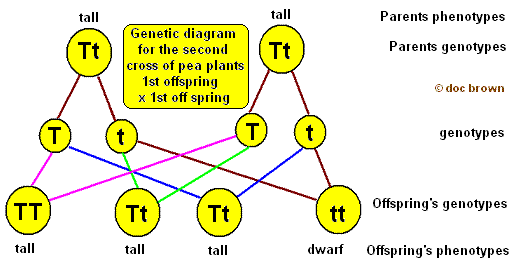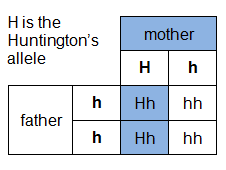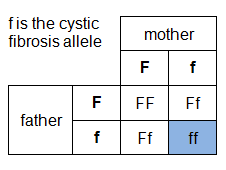HEREDITY & GENETICS
Heredity
The color of your eyes, your height, and your skin color are some traits or characteristics that are passed on to you by your parents. These are referred to as hereditary traits because they can be passed down or inherited from one generation to another.
Genetics - The scientific study of heredity
Monohybrid Inheritance - An inheritance involving only one pair of contrasting traits.
In the 19th century, an Austrian monk, Gregor Mendel, first explained how heredity might work. Mendel carried out breeding experiments on garden pea plants. For his experiments, Mendel selected several varieties of garden pea plants with one pair of contrasting traits such as:
- Plants that were either very tall or very short (dwarf)
- Plants that had either purple or white flowers
- Plants that produced either round or wrinkled seeds
Mendal also used pure-bred varieties of pea-plants. Pure bred plants are plants which, when self-fertilized, produce offspring that resemble their parent (homozygous - AA/aa).
In one experiment, Mendal crossed tall pea plants with dwarf plants. He observed that the resulting hybrids (called the F1 generation; F1 generation only applies to the offspring of pure-bred plants) were all tall.
A hybrid is the offspring of two different varieties of the same species.
He then allowed the F1 hybrids to self fertilize and produce seeds. These seeds gave rise to the F2 generation. In the F2 generation it was observed that for every one dwarf plant there were three tall plants (3:1 ratio).
In all of his experiments, Mendal observed that one trait appeared in the F1 hybrids (e.g. above all the F1 plants were tall). He called this the dominant trait. The other trait (e.g. dwarf plants in F2 generation) seemed to disappear or recede, and thus was called a recessive trait. The recessive trait reappeared in about one-quarter of the total number of F2 offspring.
Mendal made crosses for other pairs of contrasting traits in pea plants, and found that there was always a dominant and recessive trait in each specific characteristic, and the ratio in which they appeared in the F2 generation was always 3:1 (3 being dominant trait, and 1 being recessive trait).
NOTE - A large number of experiments must be carried out to find the ratio of 3:1 because the occurrence of recessive and dominant traits is based entirely on probability. There is a likely chance that in small numbers of plants, there will be more dominant traits or more recessive traits in the plants than is mentioned in the ratio.
MENDEL'S MODEL OF HEREDITY
After carrying out his experiments on peas, Mendel proposed the following:
- Heredity factors are responsible for the transmission of characteristics. These hereditary factors are now known as genes.
- Each characteristic is controlled by a pair of factors in the cells of an organism. For example, the height of a pea plant is controlled by a pair of factors. If the two factors differ, only the dominant one will show its effect.
- The two factors in each pair segregate during gamete formation. Each gamete will contain only ONE factor. This is known as Mendel's first law - Law of Segregation.
- The fusion of gametes at fertilization restores the diploid condition in the zygote, that is, the zygote contains two factors (one factor from each parent) for a particular characteristics.
- Gametes unite at random so that the ratio of characteristics among the offspring can be predicted (3:1)
Gregor Mendel & Monohybrid Inheritance
Basic Terms for Studying Heredity
Chromosome - A rod-like structure visible in the nucleus during cell division (coiled up chromatin). It is made of the molecule deoxyribonucleic acid (DNA). DNA in chromosomes carries the hereditary information for making new organisms.
Gene - A unit of inheritance, born on a particular locus (position) of a chromosome. It is a small segment of DNA in a chromosome that controls a particular characteristic or protein in an organism. Each gene has a specific function (e.g. determining height, color of eyes etc.).
Alleles - Different forms of the same gene. They occupy the same relative positions on a pair of homologous chromosomes. E.g. the gene for the height of the pea plant has two alleles: short and tall. In modern terms, Mendel's factors are alleles.
There are two types of alleles:
Dominant - Expresses itself and gives the same phenotype in both the homozygous and heterozygous conditions. Represented with capital letters.
Recessive - Does not express itself in the heterozygous condition, expresses itself only in the homozygous condition. Represented with small letters.
Homozygous - A species is said to be homozygous for a trait if the two alleles controlling that trait are identical, for example TT (two dominant alleles) or tt (two recessive alleles).
Heterozygous - A species is said to be heterozygous for a trait if the two alleles controlling it are different, for example Tt (one dominant and one recessive allele - in which case the dominant allele will show)
Homologous Chromosomes - They exist in pairs. One chromosome in their pair comes from the male parent and the other from the female parent. They are similar in size and shape (except homologous sex chromosomes) and have exactly the same order or sequence of gene loci (where the genes are located on a chromosome). The alleles present in their gene loci may not be the same.
Phenotype - Refers to the expressed trait in an organism, for example, the outward appearance of an organism. The phenotype of an organism is the result of its genes AND the effects of its environment.
Genotype - The genetic make-up (pairs of alleles) of an organism, that is, the combination of genes in an organism (all genotypic traits are not necessarily those which can be shown in the appearance [e.g. intelligence, hereditary diseases].
Genetic Diagrams
Geneticists use genetic diagrams to explain how alleles are passed on to an offspring and what will be expressed by the offspring (a genetic cross).
Some things to know:
1. An organism that is pure-bred for a trait is homozygous for that trait - this could be either homozygous recessive (tt) or homozygous dominant (TT).
2. Meiosis separates a pair of alleles by splitting up each pair of homologous chromosomes so that each gamete only receives one copy of each allele from wither parent (either allele T or t from each parent)
3. The F1 generation hybrids all have the Tt genotype (since their parents were both homozygous recessive and dominant (TT & tt --> Tt)
4. The F1 generation also produce gametes by meiosis. Each gamete will then contain either allele T or t. Random fertilization gives rise to the F2 generation of offspring (resulting in pairings TT, tt, & Tt)
5. When F1 hybrids are self-crossed, the ratio of dominant to recessive phenotypes in the F2 generation is usually close to the expected ratio of 3:1. This is especially so the case when a large number of plants are used in a breeding experiment.
Here is an example of a genetic diagram:


TT and tt are both homozygous traits, with TT being the dominant trait (tall) and tt being the recessive trait (dwarf) for the height of pea plants.
When crossed together it can be seen that all possible formations for the 4 alleles after meiosis are only Tt (hetrozygous with the dominant trait showing through) in the F1 generation.
In the F2 generation, when two plants from the F1 generation are cross bred (both hetrozygous Tt), their offspring have different results which are:
-TT
-Tt
-Tt
-tt
Thus if seen, three of the plants from this generation are likely to be tall for every one dwarfed plant, giving us the ratio 3:1.
Note that though there are two different types of allele pairs (TT & Tt), the dominant allele (tall) will show through. It is only in the homozygous recessive state (tt) will the plant be dwarfed as the recessive allele manages to show through.
Figure 1. Diagrams showing the representation of alleles for height of pea plants
Another way to express a genetic cross is to use the Punnet square. The Punnet Square is a fast and useful way of summarizing and keeping track of genetic crosses (USED FOR MONOHYBRID INHERITANCE).

Figure 2. Punnett's Square for Aa & Aa genes

Figure 3. Punnett's Square for Brown and Blue Eyes

Figure 4. Punnett's Square for the probability of Huntington's disease in offspring

Figure 5. Punnett's Square for the probability of cystic fibrosis in offspring
Co-dominance - Results when two alleles controlling a trait both express themselves in the organism.
There are exceptions to the cases where the dominant allele always expresses itself in the heterozygous state. In such cases the traits of both alleles in the heterozygous are exhibited. This is called co-dominance.
Co-dominance is exhibited in short-horned cattle. When a homozgous red bull is crossed with a homozygous white cow, the offspring in the F1 generation are 'roan', with coats consisting of a mixture of red and white hairs. In this case, both the allele for red hair, and the allele for white hair express themselves equally in the hybrid.
Another example is seen in the four o'clock plants. The plants may be homozygous for red flowers or white flowers. When they are crossed, the F1 generation consists of pink flowers since both alleles have expressed themselves.


Figure 7. Co-dominance in four o 'clock flowers
Figure 6. Co-dominance in short horned cattle
Sex Determination
Autosomes or autosomal chromosomes are the pairs of homologous chromosomes that are not in charge of the sex of the offspring.
Sex chromosomes determine the gender of the offspring.
In humans there are two sex chromosomes:
The X chromosome & the Y chromosome
A female is the XX chromosome
a male is the XY chromosome
Thus when these two chromosomes are crossed, the following are possible probabilities of the offspring's gender:
- XX
- XX
- XY
- XY
Thus it can be seen that there is a 50 % chance to have a male or female offspring. This can also be shown in a Punnett's square.


Figure 8. Chromosomes in humans
Figure 9. Punnett's Square for Sex Determination
Multiple Allele Punnett Square

Mutations
Genes are usually passed on from one generation to other unchanged. Before a cell divides, chromosomes are replicated and the genes that they carry are copied exactly. Heredity depends upon this accurate gene copying or replication.
Occasionally, an error may occur during replication of the gene or chromosome. If the error is not repaired, the gene may become modified or the chromosome may be altered.
Mutation is the sudden random change in the structure of a gene or in the chromosome number.
Gene mutation produces variation between individuals as it results in new alleles of genes. If a mutation occurs during gamete production, the resulting genetic change can be inherited by the offspring. Dominant mutations are easily detected whereas recessive ones may not be detectable for generations.
Some examples of gene mutations are:
Figure 10. Punnett's Square for Height & Skin color
Albinism
- A recessive gene mutation
- Individuals who are homozygous for the albinism allele are albinos
- Albinism is characterized by the absence of pigments in the skin, hair and eyes. Albinos are sensitive to sunlight and their skin burns easily.
Sickle-cell Anaemia
- The mutation results in a change in the structure of the gene, which is a change in the sequence of bases or nucleotides in the DNA
- The gene controlling haemoglobin production is involved in sickle-cell anaemia. The mutated gene produces haemoglobin S (HbS), which is almost the same as normal haemoglobin A (HbA) except in one amino acid. This causes a change in the three-dimensional shape of the haemoglobin molecule. HbS molecules clump together, making the cell sickle shaped.
- A recessive gene mutation
- People who are homozygous recessive for the gene have abnormal haemoglobin in their red blood cells. When oxygen concentration in their blood decreases, the red blood cells become sickle-cell shaped. This interferes with the oxygen carrying property of the red blood cells and also makes them fragile.
- The disease is fatal
Why is sickle cell anaemia so common in areas with malaria?
- Individuals who are heterozygous for the disease suffer less from the attack of malaria because a small percentage of their red blood cells are sickle-shaped. They are more resistant to malaria than individuals without the allele.
- Heterozygous individuals have a better chance of surviving and reproducing in regions where malaria is prevalent because they do not fully contract either disease.
Down's Syndrome
- Humans normally have 46 chromosomes. However, some people have one extra chromosome - they have 47 chromosomes in their body cells. Normally, zygotes with extra chromosomes would fail to develop. One of the exceptions is the zygote with an extra chromosome 21.
- The older the mother, the higher the chances that the copies of chromosomes will not separate properly during gamete formation.
MUTAGENIC AGENTS
The rate of spontaneous mutation is usually very low. However, the rate of mutation is greatly increased with the presence of certain agents in the external environment. These agents are called mutagens. Ultraviolet light, and alpha, beta and gamma radiations are mutagenic.
Some chemicals like tar and formaldehyde (found in cigarette smoke) in high concentrations are also mutagenic.
Selection
Variations in organisms may arise due to mutations. Competition for food and space occurs among these different varieties of organisms. Nature selects those varieties that are better adapted to changes in the environment, to survive and reproduce their kind. The other varieties that are susceptible to diseases or environmental changes may die. This process is called natural selection.
The process by which the present complex forms of living organisms have arisen from simpler ancestral forms is called evolution. The Theory of Evolution by Natural Selection was put forward by the English Naturalist, Charles Darwin.
An example of evolution can be seen below.

Figure 11. The different varieties of finches on Galapagos islands
ARTIFICIAL SELECTION
For thousands of years, humans have been trying to produce improved breeds of plants and animals by selective breeding. Selection is a method used to produce plants and animals with desirable traits.
Selective Breeding of Soya Bean Plants:
- Breeders want seeds that have high oil content.
1. Breeders first analyze seeds from different plants and select plants that produce seeds with high oil content. By doing so, they are actually selecting plants with good gene combinations for oil production.
2. They allow the 'good' seeds to grow into new plants and self-fertilize. The resulting seeds with the highest oil content are selected and used again as parents for the next generation.
3. After many generations, pure-breeding plants that produce seeds with the desired qualities are obtained. The plants can then be self-pollinated (without the need to select seeds) to ensure the desirable genes are inherited by future generations of plants.
Sometimes, breeders cross different varieties of plants to produce new and better variety. This is called hybridization. However, hybrids do not breed true, that is, they do not produce offspring identical to their parents. This means that either the hybrid has to be reproduced via vegetative propagation or the hybridization process has to be repeated every generation. This makes F1 hybrid seeds quite expensive.
Selective Breeding of Animals:
- Cows that produce plenty of milk and good milk are selected and used as female parents for the next generation. Breeders mate cows with desirable traits with a bull that has known required traits. This way breeders are more likely to obtain the desirable gene combination.
- Hybridization is also practiced between different breeds of animals. E.g. the Jersey cow is known to produce plenty of good milk, but it does not thrive well in warm climates. Thus it is bred with the Brahman breed of cattle (thrives well in warm climates but not good milk producers) so that the good genes from both parents are passed down to form offspring which produce plenty of milk and can thrive in warm climates.
- Many rounds of mating will be required to obtain a pure breed. So, breeders must continue to select and hybridize their cattle until they produce a new variety of cattle that contains the good qualities of both breeds. Once this is achieved, the improved breed of cattle must be maintained by inbreeding, that is, breeding among closely related individuals.